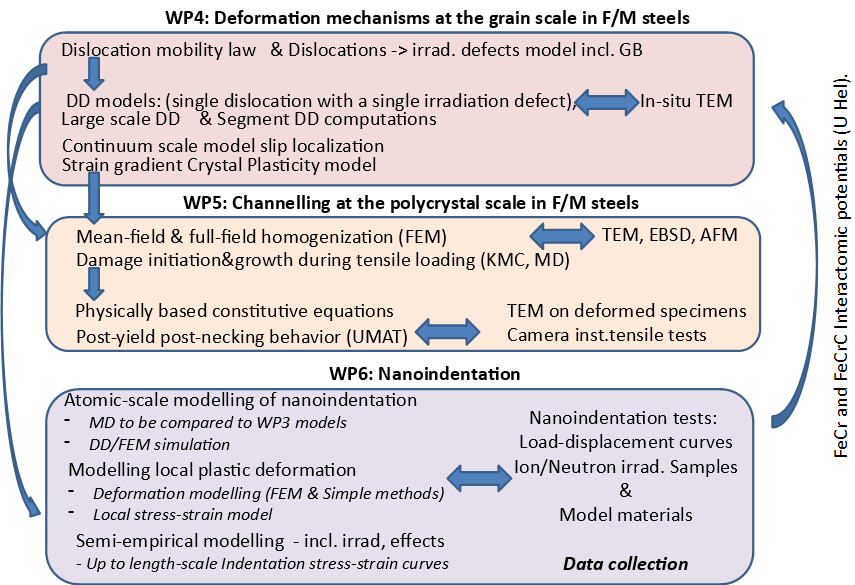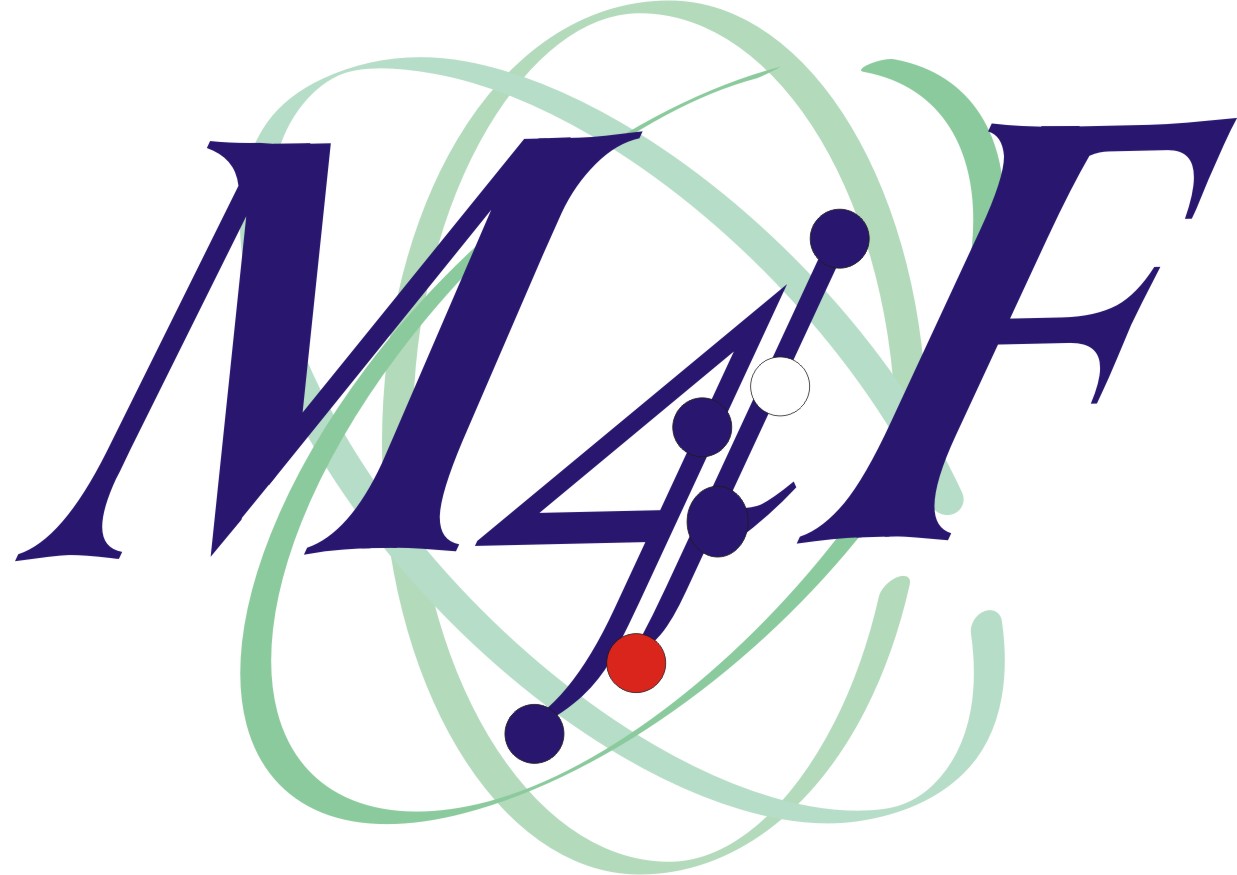Plastic flow localisation and Nanoindentation
Coordinated by Ermile Gaganidze, KIT (DE)
and David Rodney, CNRS (FR)
The aim of Domain 2 is to develop physically-based models able to predict the mechanical behaviour of irradiated F/M steels, specifically the effects of slip localisation after "low temperature" irradiation, as a consequence of the microstructural changes studied in Domain 1. A multiscale approach is adopted throughout the Domains and WP, addressing the plastic behaviour of irradiated F/M steels at the atomic, mesoscopic, crystal and polycrystal scales, using synergistically atomistic, dislocation dynamics, crystal plasticity and continuum mechanics simulations. The domain also includes experimental validation based on mechanical and microstructural characterization of neutron, ion and proton irradiated model alloys and steels. Modelling of nanoindentation process to study irradiation hardening and its impact on plastic flow localization is a one of the particular objectives of the domain.
Domain 2 is organized in three WPs according to physical scales, which have in common the study of materials subject to deformation
WP4: Deformation mechanisms at the grain scale. This WP develops dislocation dynamics models to describe deformation at grain level, accounting for the presence of irradiation defects, including the influence of alloying elements on dislocation glide and on the interaction strength between dislocations and irradiation defects. Simulations are performed at different length and timescales, from the atomic (dislocation cores) to the continuum scale (entire grain). This WP includes four tasks, three devoted to developing models operating at increasingly larger scales and limited experimental content, the fourth one eminently experimental.
WP5: Channelling at the polycrystal scale. This WP investigates channelling at the polycrystalline scale and its impact on the deformation and damage evolution. The main outcome will be the prediction of the post yield-post necking behaviour of irradiated F/M steels by using mean-field and full-field homogenization, finite element crystal plasticity and continuum mechanics modelling tools. The ultimate goal is to develop a model that provides a description of the post-yield/post-necking behaviour of irradiated F/M steels. This WP is organized in four tasks. The first three are devoted to developing models enabling the description of the macroscopic tensile behaviour of irradiated F/M steels and accounting for the cavitation mechanism in the presence of channeling. The fourth task concerns experimental activities for the validation of the models developed in the other three tasks.
WP6: Nanoindentation. This WP models nanoindentation processes of ion-irradiated materials and performs targeted experimental observations with the aim of studying irradiation hardening and understanding the effects of irradiation on the plastic flow. Ion irradiated specimens are characterized by nanoindentation using pyramidal and spherical indenters, which allow probing very shallow depths and thus extracting properties of thin layers. These experiments, together with the support of suitable models, are used to define best practices for the execution of nanoindentation tests on the small thickness within which ion irradiation affects materials.

Read recent progresses
In the period between Months 18 and 36
-
Atomic scale processes relevant to plasticity in irradiated steels accounting for the effect of C and Cr solutes on dislocations and dislocation loops as well as interaction of dislocations with grain boundaries have been studied by molecular dynamics (MD) using suitable interatomic potentials
-
In-situ straining experiments have been performed in irradiated and pristine samples in order to study the interaction between dislocations and irradiation defects and compare the observations with DD simulations.
-
The efficiency of DD simulations has been improved by developing an adapted framework to include irradiation defects and by accelerating the calculation of the elastic fields by coupling DD with a fast Fourier transform algorithm.
-
Modelling of slip localization has advanced by implementing a strain gradient crystal plasticity model that accounts for non-linear hardening and by studying plastic strain spreading in irradiated ferritic grains with a dedicated micro-model based on DD, which allows for dislocation/defect interactions and cross-slip.
-
The tensile behaviour of irradiated polycrystals has been modeled through novel mean field homogenization accounting for channel structures, as well as by developing finite elements models of polycrystalline aggregates with explicitly built-in channels.
-
Segregation energy maps for single vacancies, activation energies for single and di-vacancies, as a function of the strain perpendicular to the interface, were calculated as a pre-step for the study of the growth of voids.
-
A viscoplastic potential has been developed. True stress vs true strain curves calculated via analysis of camera instrumented tensile tests on irradiated Eurofer97 are being used for the calibration of the continuum viscoplastic model for description of post-yield post necking behavior. The implementation of finite-strain continuum model by using suitable integration scheme is in progress.
-
The characterization of irradiated and deformed specimens by both atomic-force microscopy (AFM) and field electron gun-scanning electron microscopy (FEG-SEM) are still to be carried out.
-
The possibility of using step-wise indentation in MD simulations has been further studied in order to provide information for upper scale finite element models (FEM).
-
FE simulations of nanoindentation in Eurofer97 and pure Fe are being carried out. Indentation size effects in Eurofer97 have been taken into consideration by the introduction of a scale factor in the strain gradient plasticity model.
-
The indentation process in pure Fe is being modeled based on flexible crystal plasticity laws to accommodate effects of neutron irradiation on the plastic deformation.
-
Nanoindentation experiments and analytical models to characterize irradiation damage are progressing in parallel to numerical models. The need of compensating for residual stresses, pile-up and creep effects on nanoindentation results have been evidenced as key issues in order to define accurate testing protocols to identify different types of irradiation damage.
-
Nanoindentation testing of deformed Fe and irradiated Fe, Fe-9Cr and Eurofer97 using Berkovich indenters has been performed. Irradiation hardening has been observed in Eurofer97 irradiated at 300 ºC and in Fe-9Cr irradiated at 450 ºC
Exploitation of results
The loss of uniform elongation as a consequence of low temperature neutron irradiation currently disqualifies F/M steels for application in structural components according to the existing design rules. The in-depth understanding of plastic flow localization and its impact on deformation and damage evolution in DM2, in particular the development of advanced homogenization tools accounting for the localization of deformation in channel structures, will allow the tensile behaviour of irradiated F/M steels to be predicted. The fraction of grains with channels, the mean distance between channels depending on the block orientation, as well as the mean channel plastic slip, will be predicted, too. A successful implementation of the finite strain formulation of the viscoplastic model developed in DM2, which accounts for irradiation effects and includes an appropriate ductile damage model, in the commercial code ABAQUS UMAT, will enable the description of the stress-strain response of irradiated F/M steels beyond the onset of localized plastic flow, providing a ready-to-use tool for component designers. This will open new possibilities for the reliable assessment of the component lifetime and promote rational use of post-yield post necking behaviour of F/M steels by formulating advanced, physics-based design rules.
Nanoindentation is one of the few techniques that allow the mechanical properties of ion irradiated materials to be probed in the thin thickness affected by ions. Its advantage is that it does not require the long preparation process with focused ion beam (FIB) that is typical of other mechanical tests applied to miniaturised specimens. It is thus also especially suitable in the framework of the development of autonomous materials discovery platforms. However, as well as ion irradiation experiments, its use for these purposes needs to be guided by best practices. In this context, the close collaboration developed in WP6 is pivotal in order to reach a joint understanding across groups all over Europe of factors that have to be taken into account in nanoindentation experiments and analyses, to be meaningful in the context of fission and fusion materials. The elaboration of agreed upon methodologies and the generation of sound data is crucial to verify/calibrate advanced models or improve insight into the materials' irradiation response. Enabling a Materials Database to host nanoindentation data and the development of an interoperable format for nanoindentation test data will finally contribute to the electronic sharing and reusability of nanomechanical test data after completion of the project. This dataset, if progressively extended, will enable the elaboration of data-driven, artificial-intelligence based models relating composition, basic microstructural features and irradiation conditions to the nanoindentation response, thereby opening the way to the creation of high-throughput platforms for the optimization of materials.

